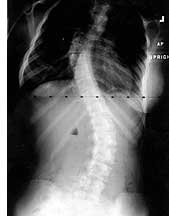SCOLIOSIS TREATMENT
Everyone's spine has curves. These curves produce the normal rounding
of the shoulder and the sway of the lower back.
The word scoliosis
(say: sko-lee-oh-sus) comes from a Greek word meaning
crooked. If you have scoliosis, you're not alone. About three out of
every 100 people have some form of scoliosis, though for many people
it's not much of a problem. For a small number of people, the curve gets
worse as they grow and they may need a brace or an operation to correct
it.

A spine with scoliosis has abnormal curves with a rotational deformity.
This means that the spine turns on its axis like a corkscrew. Compare
the more subtle curve of the normal spine to the severe curvature of the
scoliotic spine.
Scoliosis is an abnormal curve of the spine (backbone). With
scoliosis, the spine isn't straight. Instead, the spine is crooked and
curves to the side. If the spine is very crooked, the ribs or hips may
stick out more on one side than the other side. Also, one shoulder may
be lower than the other. Scoliosis may begin in childhood but often is
not noticed until the teenage years. In most cases, the exact cause of
scoliosis isn't known. It seems to run in some families. Scoliosis is
more common in girls than in boys.